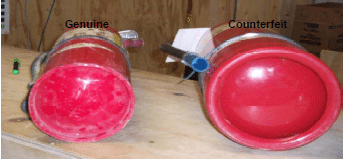March 21, 2013 Alert 01-13
Washington, DC
The Coast Guard has recently become aware of counterfeits of U.S. Coast Guard approved portable fire extinguishers manufactured by Amerex Corporation and Buckeye Fire Equipment. Both companies are major producers of genuine approved fire extinguishing equipment and serve a worldwide market. These counterfeit extinguishers present a significant safety hazard. Their capability to extinguish a fire is unproven; they may be charged with a powdery substance that is not a fire extinguishing agent, the pressure cylinder is not DOT approved, and the pressure gauge may not function or give false readings.




